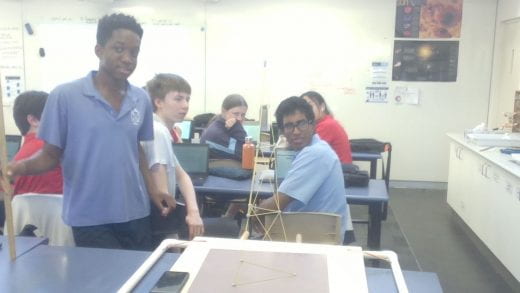This term in science, our task was to research and design an earthquake proof building out of spaghetti and BluTack. The first step was to find strong shapes and find out more about earthquake buildings. We found that the strongest shape was a triangle, so we added as many triangles into the design as possible, including the base, crossbeams, and levels. We had to stay inside of a budget as well as remaining over 60cm tall, (before and after testing). After fully constructing and testing the spaghetti tower on an earthquake simulation table we had to assess the tower (fallen or standing) for flaws and ways to improve. After making the reasonable changes, it was tested again.  We chose this design of a tower in the shape of an isosceles triangle. From our research showed that a triangle is the strongest shape. A triangle would also be cheaper than a shape with more sides because it uses less materials. We added crossbeams to the bottom layers to give it extra support, but we didn’t add one to the highest layer to lake it as light at possible.
We chose this design of a tower in the shape of an isosceles triangle. From our research showed that a triangle is the strongest shape. A triangle would also be cheaper than a shape with more sides because it uses less materials. We added crossbeams to the bottom layers to give it extra support, but we didn’t add one to the highest layer to lake it as light at possible.
When budgeting for the tower, we had to keep in mind that…
- 10cm spaghetti is $1
- 25cm spaghetti is $2.5
- 1g BluTack is $1
- The base had to be within 30cm x 30cm
- The tower had to remain above 60cm before and after testing
For our budget, we spent $13 on BluTack, $45.50 on spaghetti and had $1.50 left over.
The damage that the building was left with after the simulated earthquake was predominantly caused by the embellishment on the top. The two grams of BluTack was too much for the middle layer to withstand. this damage was seen after 5-10 seconds, and only the higher two layers fell. The base was strong and stayed stable, but the joints were unstable.
When rebuilding, the first change we made was the way we built it. Instead of building it up, we constructed it modularly. This meant we built each of the layers separately then stacked them. this changed the build because it was more secure. there ended up being more BluTack on the joints because of this and there were less holes in BluTack too. The removal of the embellishment also greatly improved it up until the last stage of testing. It removed the excess weight, so the tower could stay up for longer.
After making these changes to the tower, it remained standing for a lot longer. The embellishment not being on the top made a large impact on this, and the reason it fell was not due to the weight disproportion. It lasted through the simulated P waves and S waves, but in the surface wave the top half of the tower fell off. I think this was due to the joints between the base and middle layer.
If I were to do this task again, I would once again build it modularly to remain stability, just add as much BluTack possible to the lower joints.
